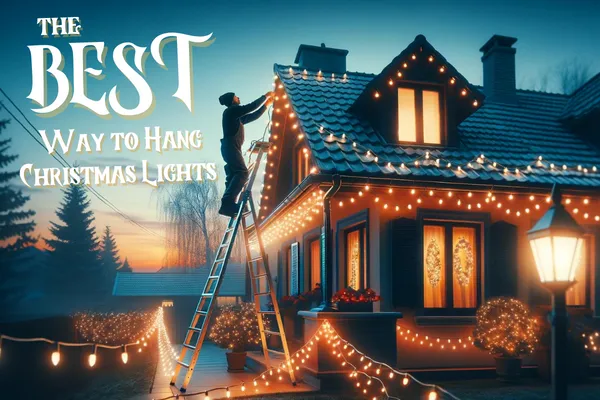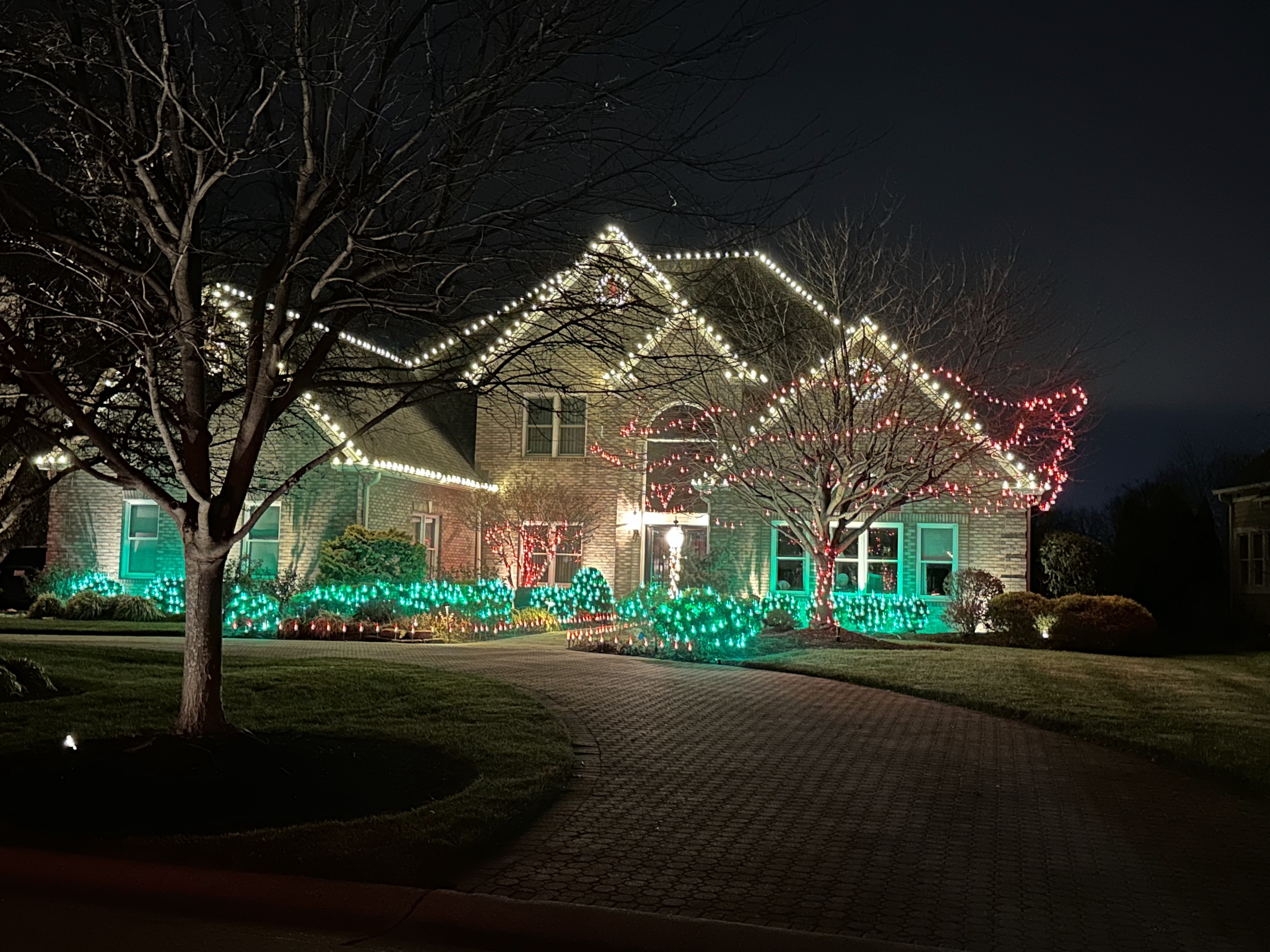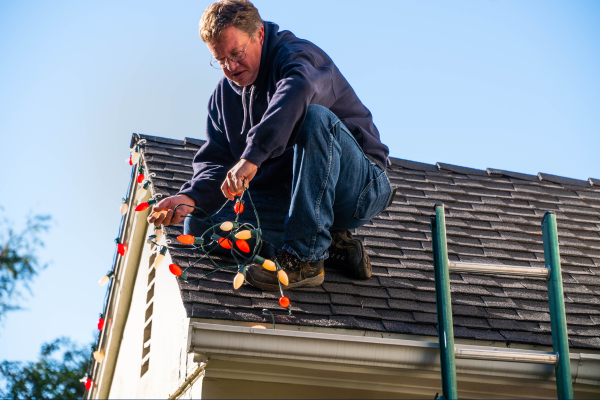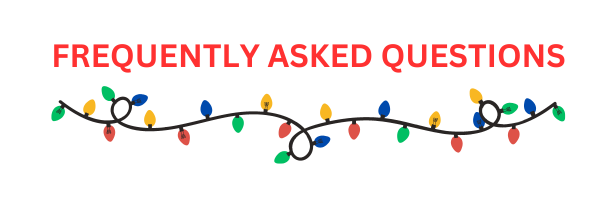Blog
Our Top Blog Posts

The Best Way to Hang Christmas Lights
As you plan, prepare, and ponder the best way to hang your Christmas lights, remember that the success of your festive display hinges not just on the lights you choose but also on the strategy you employ. You'll need to consider the type of lights that best suit your home, the safest way to secure them, and how to ensure they shine brightly throughout the season. This guide aims to equip you with the knowledge to not only make your home the envy of the neighborhood but also keep your holiday season merry and bright. But before you climb that ladder, there's one crucial step you shouldn't overlook—let's explore what that is and why it could make all the difference in your holiday display.

Planning and Preparation
Before you dive into the festive task of hanging Christmas lights, it's crucial to sketch your design and measure the intended area to ensure you have all the necessary equipment and the right attire for the job. This initial step isn't just about making your home the brightest on the block; it's about ensuring safety and efficiency throughout the process. You don't want to find yourself halfway up a ladder only to realize you're short on lights or, worse, that you're wearing the wrong shoes for the job.
First off, grab a notepad and start visualizing your holiday masterpiece. Think about where you want those twinkling lights to go. Are you outlining the roof, decking out bushes, or wrapping them around columns? Jot down your ideas and then, tape measure in hand, calculate the length of lights you'll need. Remember, it's better to overestimate a bit than to run short.
Next, consider the equipment. Besides the lights, you'll need clips or hooks designed specifically for hanging lights, a sturdy ladder that reaches your highest point, and possibly a friend or family member to spot you as you climb. Don't overlook the importance of your attire: comfortable, non-slip shoes and clothes that won't snag or restrict movement are key. Also see How To Install Christmas Lights On Gutters With Gutter Guards for more information on supplies for gutters.
If the project seems overwhelming, or if safety concerns arise, don't hesitate to seek professional help. Hanging Christmas lights can be a big task, and there's no shame in calling in the experts to ensure it's done safely and beautifully. After all, the goal is to brighten up your home, not to take unnecessary risks.

Testing and Maintenance
Once you've planned your Christmas light display, it's crucial to test each strand and replace any faulty bulbs to ensure a smooth and bright setup. Before you start hanging your lights, plug each strand in to make sure they're all working correctly. It's a simple step, but it's easy to overlook in the excitement of decorating. Finding a strand that's half-lit when you're halfway up a ladder is frustrating and time-consuming to fix.
If you spot any dead bulbs, replace them right away. Keeping extra bulbs on hand is a smart move; you won't have to scramble to find replacements at the last minute. It's also worth considering switching to LED bulbs if you haven't already. They're more energy-efficient and have a longer lifespan than traditional bulbs, which means you'll be replacing them less often.
Maintenance doesn't stop after the initial setup. Check your lights periodically throughout the season, especially after bad weather. Wind and rain can loosen bulbs and wires, so it's important to make sure everything is secure and functioning properly. If you notice any issues, it's best to address them during the day when visibility is better and it's safer to climb ladders.
Choosing the Right Lights
Selecting the right lights often determines the success and durability of your Christmas display. It's crucial to choose lights designed to withstand the elements if they'll be outdoors. Check the packaging to ensure you're picking lights meant for external use and order extra bulbs for inevitable replacements. Indoor lights might be tempting to use outside due to their variety or because you already have them, but resist the urge. They're not made to endure winter weather and could lead to safety hazards.
When shopping, you'll find a plethora of options, from traditional incandescent bulbs to energy-efficient LEDs. LEDs are your best bet for several reasons. They consume less electricity, which can significantly lower your energy bill during the holiday season. Plus, they tend to last longer than their incandescent counterparts, making them a more sustainable choice in the long run.
Moreover, consider the ambiance you want to create. Warm white lights offer a cozy, traditional glow, while cool white or multicolored LEDs can deliver a more vibrant or festive atmosphere. It's all about matching the light type with your envisioned display.
Lastly, don't forget to check for compatibility with any existing lights or decorations. Mixing different types or brands can sometimes lead to mismatched lighting effects, which might not align with your intended aesthetic. Stick to a coherent theme to ensure your display looks unified and intentional.
Measuring and Estimating
Accurately measuring your space is crucial to determine how many Christmas lights you'll need for your display. Start by sketching out your design, then grab a measuring tape to get the lengths of the areas you plan to decorate. This includes eaves, windows, doors, and any bushes or trees you want to light up. Don't forget to measure the distance to your power source, as this could affect where you begin and end your light display.
When estimating the number of lights, a general rule is to aim for about 100-150 lights per linear foot for a bright display. However, your personal preference for how dense or sparse you want the lights plays a big part. If you're wrapping trees or bushes, consider their girth as well as height. A fuller look requires more lights.
Instead of getting bogged down in exact measurements, use innovative techniques for relative measurements. For instance, you can use your stride to approximate longer distances, keeping in mind that an average person's stride is roughly 2.5 feet. This method won't replace precise measurements but can give you a quick estimate when planning.

Tools and Equipment Usage
To ensure a smooth installation of your Christmas lights, you'll need to gather the right tools and equipment beforehand. This preparation step is crucial for a hassle-free experience. Start by choosing light clips or hooks specifically designed for hanging Christmas lights. These will securely hold your lights in place without damaging your home's exterior.
You'll also need a sturdy ladder. Make sure it's tall enough to safely reach the areas where you're installing the lights. Before climbing, always check that the ladder is stable and positioned on even ground. Safety should be your top priority, so don't take any risks by overreaching or using a ladder that isn't up to the task.
Wearing appropriate clothing is equally important. Opt for clothes that won't snag on anything and shoes with good grip to avoid slips and falls. This might not seem like a big deal, but correct attire can prevent accidents and keep you comfortable while working.
Avoid using staples or nails to hang your lights, as these can damage the wires and lead to potential hazards. Instead, stick to the clips or hooks you've gathered. Additionally, ensure you use outdoor-rated extension cords to power your lights. These are designed to withstand the elements and provide a safe, reliable connection.

Can I Synchronize Christmas Lights to Music, and if So, How?
Yes, you can synchronize Christmas lights to music. Start by choosing a control system designed for syncing lights with music, which you'll find online or at specialty stores. Download software that'll let you choreograph your light show to your favorite tunes. You'll need a computer or a smart device to run the software. Then, connect your lights to the control system, set up your music playlist, and enjoy your synchronized light show!
How Do I Ensure the Safety of My Outdoor Christmas Lights in Extreme Weather Conditions?
Facing extreme weather, you're playing a high-stakes game with your outdoor Christmas lights. First, ensure they're specifically designed for outdoor use to withstand elements. Before the storm hits, test all bulbs and secure them with commercial clips, not nails or staples, to avoid damage. Opt for LED bulbs—they're more durable and energy-efficient. Lastly, keep extra bulbs handy for quick replacements. This proactive approach keeps your display shining bright, come rain or shine.
What Are the Most Energy-Efficient Christmas Lights, and How Can Their Use Impact My Electricity Bill?
You're wondering about the most energy-efficient Christmas lights and their impact on your electricity bill. LED lights are your best bet. They use at least 75% less energy and last 25 times longer than traditional incandescent lights. This choice can significantly lower your bill during the holiday season. You'll save money in the long run, despite the higher upfront cost, making them a smart, eco-friendly investment for your festive decorations.
How do I safely remove and replace burnt-out Christmas lights?
Turn off and unplug the light string before attempting to replace any bulbs. Use a bulb tester to identify the burnt-out bulb. Gently remove the defective bulb by pulling it straight out of the socket. If it's stuck, carefully wiggle it back and forth until it loosens. Insert the replacement bulb by pushing it firmly into the socket. Test the light string again to ensure it's working properly.
Can LED and incandescent Christmas lights be used together?
It is not recommended to mix LED and incandescent lights on the same circuit or string because they have different voltage requirements and power consumption levels. Doing so can lead to premature failure of the lights or pose a safety hazard. It's best to use one type consistently throughout your display.

What do I do if an entire string of Christmas lights goes out?
First, check the fuse in the plug, as it might have blown. Most light strings come with replacement fuses. If the fuse is fine, use a bulb tester to check for faulty bulbs that need replacement. Sometimes, a single burnt-out bulb can cause the entire string to stop working. If all bulbs seem fine, inspect the wiring for any visible damage.
How many Christmas light strings can I safely connect together?
This depends on the type of lights (LED or incandescent) and the specifications provided by the manufacturer. LEDs consume less power, allowing more strings to be connected end-to-end compared to incandescent lights. Always refer to the manufacturer's guidelines to avoid overloading your electrical circuit, which can be a fire hazard.
How can I extend the lifespan of my Christmas lights?
Store your Christmas lights carefully by winding them around a reel or a piece of cardboard to prevent tangling and damage. Keep them in a cool, dry place to avoid moisture damage. When installing the lights, avoid pulling them too tight or twisting them, as this can strain the wires. Finally, turning the lights off overnight or when not in use can significantly extend their lifespan by reducing wear and tear.

The Best Way to Hang Christmas Lights
As you plan, prepare, and ponder the best way to hang your Christmas lights, remember that the success of your festive display hinges not just on the lights you choose but also on the strategy you employ. You'll need to consider the type of lights that best suit your home, the safest way to secure them, and how to ensure they shine brightly throughout the season. This guide aims to equip you with the knowledge to not only make your home the envy of the neighborhood but also keep your holiday season merry and bright. But before you climb that ladder, there's one crucial step you shouldn't overlook—let's explore what that is and why it could make all the difference in your holiday display.

Planning and Preparation
Before you dive into the festive task of hanging Christmas lights, it's crucial to sketch your design and measure the intended area to ensure you have all the necessary equipment and the right attire for the job. This initial step isn't just about making your home the brightest on the block; it's about ensuring safety and efficiency throughout the process. You don't want to find yourself halfway up a ladder only to realize you're short on lights or, worse, that you're wearing the wrong shoes for the job.
First off, grab a notepad and start visualizing your holiday masterpiece. Think about where you want those twinkling lights to go. Are you outlining the roof, decking out bushes, or wrapping them around columns? Jot down your ideas and then, tape measure in hand, calculate the length of lights you'll need. Remember, it's better to overestimate a bit than to run short.
Next, consider the equipment. Besides the lights, you'll need clips or hooks designed specifically for hanging lights, a sturdy ladder that reaches your highest point, and possibly a friend or family member to spot you as you climb. Don't overlook the importance of your attire: comfortable, non-slip shoes and clothes that won't snag or restrict movement are key. Also see How To Install Christmas Lights On Gutters With Gutter Guards for more information on supplies for gutters.
If the project seems overwhelming, or if safety concerns arise, don't hesitate to seek professional help. Hanging Christmas lights can be a big task, and there's no shame in calling in the experts to ensure it's done safely and beautifully. After all, the goal is to brighten up your home, not to take unnecessary risks.

Testing and Maintenance
Once you've planned your Christmas light display, it's crucial to test each strand and replace any faulty bulbs to ensure a smooth and bright setup. Before you start hanging your lights, plug each strand in to make sure they're all working correctly. It's a simple step, but it's easy to overlook in the excitement of decorating. Finding a strand that's half-lit when you're halfway up a ladder is frustrating and time-consuming to fix.
If you spot any dead bulbs, replace them right away. Keeping extra bulbs on hand is a smart move; you won't have to scramble to find replacements at the last minute. It's also worth considering switching to LED bulbs if you haven't already. They're more energy-efficient and have a longer lifespan than traditional bulbs, which means you'll be replacing them less often.
Maintenance doesn't stop after the initial setup. Check your lights periodically throughout the season, especially after bad weather. Wind and rain can loosen bulbs and wires, so it's important to make sure everything is secure and functioning properly. If you notice any issues, it's best to address them during the day when visibility is better and it's safer to climb ladders.
Choosing the Right Lights
Selecting the right lights often determines the success and durability of your Christmas display. It's crucial to choose lights designed to withstand the elements if they'll be outdoors. Check the packaging to ensure you're picking lights meant for external use and order extra bulbs for inevitable replacements. Indoor lights might be tempting to use outside due to their variety or because you already have them, but resist the urge. They're not made to endure winter weather and could lead to safety hazards.
When shopping, you'll find a plethora of options, from traditional incandescent bulbs to energy-efficient LEDs. LEDs are your best bet for several reasons. They consume less electricity, which can significantly lower your energy bill during the holiday season. Plus, they tend to last longer than their incandescent counterparts, making them a more sustainable choice in the long run.
Moreover, consider the ambiance you want to create. Warm white lights offer a cozy, traditional glow, while cool white or multicolored LEDs can deliver a more vibrant or festive atmosphere. It's all about matching the light type with your envisioned display.
Lastly, don't forget to check for compatibility with any existing lights or decorations. Mixing different types or brands can sometimes lead to mismatched lighting effects, which might not align with your intended aesthetic. Stick to a coherent theme to ensure your display looks unified and intentional.
Measuring and Estimating
Accurately measuring your space is crucial to determine how many Christmas lights you'll need for your display. Start by sketching out your design, then grab a measuring tape to get the lengths of the areas you plan to decorate. This includes eaves, windows, doors, and any bushes or trees you want to light up. Don't forget to measure the distance to your power source, as this could affect where you begin and end your light display.
When estimating the number of lights, a general rule is to aim for about 100-150 lights per linear foot for a bright display. However, your personal preference for how dense or sparse you want the lights plays a big part. If you're wrapping trees or bushes, consider their girth as well as height. A fuller look requires more lights.
Instead of getting bogged down in exact measurements, use innovative techniques for relative measurements. For instance, you can use your stride to approximate longer distances, keeping in mind that an average person's stride is roughly 2.5 feet. This method won't replace precise measurements but can give you a quick estimate when planning.

Tools and Equipment Usage
To ensure a smooth installation of your Christmas lights, you'll need to gather the right tools and equipment beforehand. This preparation step is crucial for a hassle-free experience. Start by choosing light clips or hooks specifically designed for hanging Christmas lights. These will securely hold your lights in place without damaging your home's exterior.
You'll also need a sturdy ladder. Make sure it's tall enough to safely reach the areas where you're installing the lights. Before climbing, always check that the ladder is stable and positioned on even ground. Safety should be your top priority, so don't take any risks by overreaching or using a ladder that isn't up to the task.
Wearing appropriate clothing is equally important. Opt for clothes that won't snag on anything and shoes with good grip to avoid slips and falls. This might not seem like a big deal, but correct attire can prevent accidents and keep you comfortable while working.
Avoid using staples or nails to hang your lights, as these can damage the wires and lead to potential hazards. Instead, stick to the clips or hooks you've gathered. Additionally, ensure you use outdoor-rated extension cords to power your lights. These are designed to withstand the elements and provide a safe, reliable connection.

Can I Synchronize Christmas Lights to Music, and if So, How?
Yes, you can synchronize Christmas lights to music. Start by choosing a control system designed for syncing lights with music, which you'll find online or at specialty stores. Download software that'll let you choreograph your light show to your favorite tunes. You'll need a computer or a smart device to run the software. Then, connect your lights to the control system, set up your music playlist, and enjoy your synchronized light show!
How Do I Ensure the Safety of My Outdoor Christmas Lights in Extreme Weather Conditions?
Facing extreme weather, you're playing a high-stakes game with your outdoor Christmas lights. First, ensure they're specifically designed for outdoor use to withstand elements. Before the storm hits, test all bulbs and secure them with commercial clips, not nails or staples, to avoid damage. Opt for LED bulbs—they're more durable and energy-efficient. Lastly, keep extra bulbs handy for quick replacements. This proactive approach keeps your display shining bright, come rain or shine.
What Are the Most Energy-Efficient Christmas Lights, and How Can Their Use Impact My Electricity Bill?
You're wondering about the most energy-efficient Christmas lights and their impact on your electricity bill. LED lights are your best bet. They use at least 75% less energy and last 25 times longer than traditional incandescent lights. This choice can significantly lower your bill during the holiday season. You'll save money in the long run, despite the higher upfront cost, making them a smart, eco-friendly investment for your festive decorations.
How do I safely remove and replace burnt-out Christmas lights?
Turn off and unplug the light string before attempting to replace any bulbs. Use a bulb tester to identify the burnt-out bulb. Gently remove the defective bulb by pulling it straight out of the socket. If it's stuck, carefully wiggle it back and forth until it loosens. Insert the replacement bulb by pushing it firmly into the socket. Test the light string again to ensure it's working properly.
Can LED and incandescent Christmas lights be used together?
It is not recommended to mix LED and incandescent lights on the same circuit or string because they have different voltage requirements and power consumption levels. Doing so can lead to premature failure of the lights or pose a safety hazard. It's best to use one type consistently throughout your display.

What do I do if an entire string of Christmas lights goes out?
First, check the fuse in the plug, as it might have blown. Most light strings come with replacement fuses. If the fuse is fine, use a bulb tester to check for faulty bulbs that need replacement. Sometimes, a single burnt-out bulb can cause the entire string to stop working. If all bulbs seem fine, inspect the wiring for any visible damage.
How many Christmas light strings can I safely connect together?
This depends on the type of lights (LED or incandescent) and the specifications provided by the manufacturer. LEDs consume less power, allowing more strings to be connected end-to-end compared to incandescent lights. Always refer to the manufacturer's guidelines to avoid overloading your electrical circuit, which can be a fire hazard.
How can I extend the lifespan of my Christmas lights?
Store your Christmas lights carefully by winding them around a reel or a piece of cardboard to prevent tangling and damage. Keep them in a cool, dry place to avoid moisture damage. When installing the lights, avoid pulling them too tight or twisting them, as this can strain the wires. Finally, turning the lights off overnight or when not in use can significantly extend their lifespan by reducing wear and tear.
Copyright ©2025 All Right Reserved website designed by christmaslights.io
Terms of Service / Privacy Policy
Have questions or need assistance?
Contact us at (855)619-LITE


